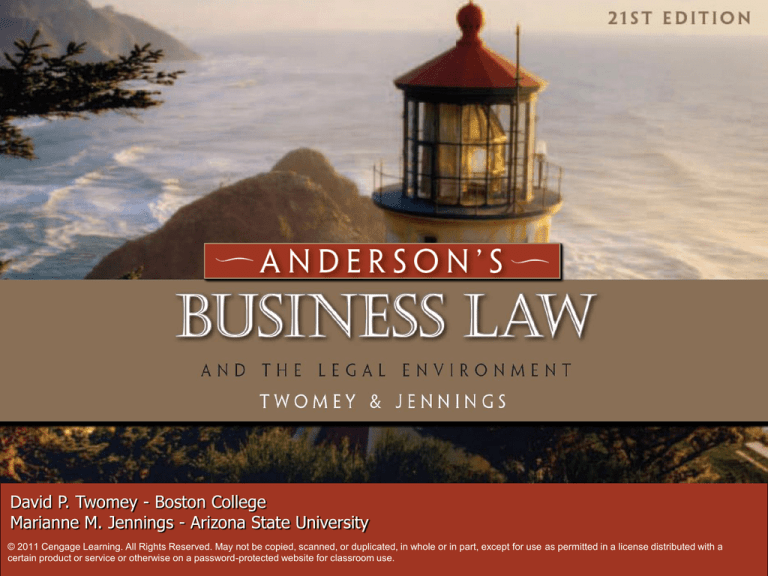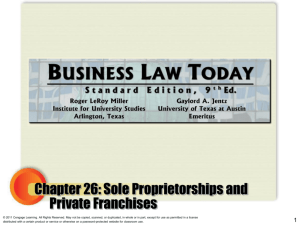
David P. Twomey - Boston College
Marianne M. Jennings - Arizona State University
1
© 2011 Cengage Learning. All Rights Reserved. May not be copied, scanned, or duplicated, in whole or in part, except for use as permitted in a license distributed with a
© 2011 Cengage Learning. All Rights Reserved. May not be copied, scanned, or duplicated, in whole or in part, except for
certain
product or service or otherwise on a password-protected website for classroom use.
use as permitted in a license distributed with a certain product or service or otherwise on a password-protected website for
classroom use.
Chapter 9
Torts
Twomey-Jennings, Anderson’s Business Law and the Legal Environment, 21st Ed.
© 2011 Cengage Learning. All Rights Reserved. May not be copied, scanned, or duplicated, in whole or in part, except for use as
permitted in a license distributed with a certain product or service or otherwise on a password-protected website for classroom use.
2
A. General Principles
1. What Is A Tort?
2. Tort And Crime Distinguished
3. Types Of Torts
Twomey-Jennings, Anderson’s Business Law and the Legal Environment, 21st Ed.
© 2011 Cengage Learning. All Rights Reserved. May not be copied, scanned, or duplicated, in whole or in part, except for use as
permitted in a license distributed with a certain product or service or otherwise on a password-protected website for classroom use.
3
A. General Principles
1. What is a Tort?
–
Tort is a non-criminal or civil injury to a
person or her property interests.
2. Torts and Crime Distinguished. [LO.1]
–
–
Crime arises from violation of public duty,
whereas tort arises from violation of private
duty.
Same act can be both a crime and a tort.
Twomey-Jennings, Anderson’s Business Law and the Legal Environment, 21st Ed.
© 2011 Cengage Learning. All Rights Reserved. May not be copied, scanned, or duplicated, in whole or in part, except for use as
permitted in a license distributed with a certain product or service or otherwise on a password-protected website for classroom use.
4
A. General Principles
3. Types of Torts:
–
–
–
Intentional: substantial certainty.
Negligence: breach of standard of care.
Strict Liability: liability without fault.
Twomey-Jennings, Anderson’s Business Law and the Legal Environment, 21st Ed.
© 2011 Cengage Learning. All Rights Reserved. May not be copied, scanned, or duplicated, in whole or in part, except for use as
permitted in a license distributed with a certain product or service or otherwise on a password-protected website for classroom use.
5
B. Intentional Torts
4. Assault
5. Battery
6. False Imprisonment
7. Intentional Infliction Of Emotional
Distress
8. Invasion Of Privacy
Twomey-Jennings, Anderson’s Business Law and the Legal Environment, 21st Ed.
© 2011 Cengage Learning. All Rights Reserved. May not be copied, scanned, or duplicated, in whole or in part, except for use as
permitted in a license distributed with a certain product or service or otherwise on a password-protected website for classroom use.
6
B. Intentional Torts
9. Defamation
10. Product Disparagement
11. Wrongful Interference With Contracts
12. Trespass
Twomey-Jennings, Anderson’s Business Law and the Legal Environment, 21st Ed.
© 2011 Cengage Learning. All Rights Reserved. May not be copied, scanned, or duplicated, in whole or in part, except for use as
permitted in a license distributed with a certain product or service or otherwise on a password-protected website for classroom use.
7
B. Intentional Torts
4. Assault: Fear of imminent harm with means to
do it. [LO.2]
5. Battery: intentional, wrongful touching of another
(the completion of the assault).
6. False Imprisonment.
–
–
Intentional detention without consent.
Shopkeeper’s Privilege permits detention for
reasonable time with reasonable suspicion.
Dillard Department Stores case: Shopkeeper’s
Privilege did not apply because the detention was not
in a reasonable manner.
Twomey-Jennings, Anderson’s Business Law and the Legal Environment, 21st Ed.
© 2011 Cengage Learning. All Rights Reserved. May not be copied, scanned, or duplicated, in whole or in part, except for use as
permitted in a license distributed with a certain product or service or otherwise on a password-protected website for classroom use.
8
B. Intentional Torts
7. Intentional Infliction of Emotional Distress.
–
Outrageous conduct which goes beyond all
bounds of decency.
8. Invasion of Privacy. [LO.3]
(A) Intrusion into plaintiff’s private affairs.
(B) Public disclosure of private facts.
(C) Appropriation of another’s image or likeness
for commercial advantage.
Bosley case: anchor’s wet t-shirt image was
used without consent for profit.
Twomey-Jennings, Anderson’s Business Law and the Legal Environment, 21st Ed.
© 2011 Cengage Learning. All Rights Reserved. May not be copied, scanned, or duplicated, in whole or in part, except for use as
permitted in a license distributed with a certain product or service or otherwise on a password-protected website for classroom use.
9
B. Intentional Torts
9. Defamation.
–
–
–
Untrue statement published to a third party
that damages a person’s property interest.
Slander is oral defamation.
Libel is written (broadcast, internet).
Twomey-Jennings, Anderson’s Business Law and the Legal Environment, 21st Ed.
© 2011 Cengage Learning. All Rights Reserved. May not be copied, scanned, or duplicated, in whole or in part, except for use as
permitted in a license distributed with a certain product or service or otherwise on a password-protected website for classroom use.
10
B. Intentional Torts
9. Defamation: Privilege. [LO.4]
–
–
–
Absolute Privilege: when members of
Congress speaking on floor of senate or
House, witnesses in court proceedings.
Qualified Privilege: as long as released
without malice and a retraction is made.
Qualified Privilege extends to workplace
when statement is made to protect interests
of private employer.
Twomey-Jennings, Anderson’s Business Law and the Legal Environment, 21st Ed.
© 2011 Cengage Learning. All Rights Reserved. May not be copied, scanned, or duplicated, in whole or in part, except for use as
permitted in a license distributed with a certain product or service or otherwise on a password-protected website for classroom use.
11
B. Intentional Torts
9. Defamation: Privilege. [LO.4]
–
New Statutory Privilege: for truthful letters of
recommendation about former employees.
Randi W. v. Muroc case: misleading letters of
recommendation give rise to employer liability.
Twomey-Jennings, Anderson’s Business Law and the Legal Environment, 21st Ed.
© 2011 Cengage Learning. All Rights Reserved. May not be copied, scanned, or duplicated, in whole or in part, except for use as
permitted in a license distributed with a certain product or service or otherwise on a password-protected website for classroom use.
12
B. Intentional Torts
10. Product Disparagement.
–
–
False statement about a product.
Slander of Title/Trade Libel.
11. Wrongful Interference with Contracts.
–
Third party (A) substantially interferes with a
contract between B and C, causing either B or
C to break the contract.
12. Trespass.
Twomey-Jennings, Anderson’s Business Law and the Legal Environment, 21st Ed.
© 2011 Cengage Learning. All Rights Reserved. May not be copied, scanned, or duplicated, in whole or in part, except for use as
permitted in a license distributed with a certain product or service or otherwise on a password-protected website for classroom use.
13
C. Negligence
13. Elements Of Negligence
14. Defenses To Negligence
Twomey-Jennings, Anderson’s Business Law and the Legal Environment, 21st Ed.
© 2011 Cengage Learning. All Rights Reserved. May not be copied, scanned, or duplicated, in whole or in part, except for use as
permitted in a license distributed with a certain product or service or otherwise on a password-protected website for classroom use.
14
C. Negligence
Negligence exists when a person acts with less
care than is reasonable, causing foreseeable
injury. [LO.5]
13. Elements:
(A) Duty to Exercise Reasonable Care.
•
Professionals: Malpractice.
(B) Breach of Duty.
•
•
By statute or reasonable person standard.
May be established by an ‘expert’.
Twomey-Jennings, Anderson’s Business Law and the Legal Environment, 21st Ed.
© 2011 Cengage Learning. All Rights Reserved. May not be copied, scanned, or duplicated, in whole or in part, except for use as
permitted in a license distributed with a certain product or service or otherwise on a password-protected website for classroom use.
15
C. Negligence
13. Elements:
(C) Causation. Connects duty with injuries to
plaintiff.
‒ “But For” defendant’s action, plaintiff would
not have suffered the injury.
‒ Proximate Cause: plaintiff’s injury was
foreseeable. Palsgraf case: Plaintiff was too
far away for injury to be foreseeable.
Twomey-Jennings, Anderson’s Business Law and the Legal Environment, 21st Ed.
© 2011 Cengage Learning. All Rights Reserved. May not be copied, scanned, or duplicated, in whole or in part, except for use as
permitted in a license distributed with a certain product or service or otherwise on a password-protected website for classroom use.
16
C. Negligence
13. Elements:
(D) Damages.
‒ Past and future pain and suffering, physical
impairment, medical care, loss of earning
capacity. Experts help juries “quantify” the
injuries.
‒ Joint and Several Liability: when actions of
two or more defendants impose liability on
all actors. Each one is responsible for all
injuries.
Twomey-Jennings, Anderson’s Business Law and the Legal Environment, 21st Ed.
© 2011 Cengage Learning. All Rights Reserved. May not be copied, scanned, or duplicated, in whole or in part, except for use as
permitted in a license distributed with a certain product or service or otherwise on a password-protected website for classroom use.
17
C. Negligence
14. Defenses to Negligence.
(A) Contributory Negligence: plaintiff’s partial
negligence bars recovery for his injuries.
Hardesty v. American Seating case: plaintiff’s
negligence was a bar to recovery in Maryland.
(B) Comparative Negligence: determines the
fault of both parties. If Plaintiff is >50% at
fault, he recovers nothing.
Twomey-Jennings, Anderson’s Business Law and the Legal Environment, 21st Ed.
© 2011 Cengage Learning. All Rights Reserved. May not be copied, scanned, or duplicated, in whole or in part, except for use as
permitted in a license distributed with a certain product or service or otherwise on a password-protected website for classroom use.
18
C. Negligence
14. Defenses to Negligence. (continued)
(C) Assumption of Risk: burden is on defendant
to prove plaintiff knew about risk and chose
to proceed.
• Express Assumption: usually exculpatory writing.
• Implied Assumption: subjective, based on
circumstances.
(D) Immunity: governments are generally
immune from tort liability.
Twomey-Jennings, Anderson’s Business Law and the Legal Environment, 21st Ed.
© 2011 Cengage Learning. All Rights Reserved. May not be copied, scanned, or duplicated, in whole or in part, except for use as
permitted in a license distributed with a certain product or service or otherwise on a password-protected website for classroom use.
19
D. Strict Liability
15. What Is Strict Liability?
16. Imposing Strict Liability
Twomey-Jennings, Anderson’s Business Law and the Legal Environment, 21st Ed.
© 2011 Cengage Learning. All Rights Reserved. May not be copied, scanned, or duplicated, in whole or in part, except for use as
permitted in a license distributed with a certain product or service or otherwise on a password-protected website for classroom use.
20
D. Strict Liability
15. What is Strict Liability? [LO.6]
–
Absolute liability imposed by law to protect
the public or ultra-hazardous activities such
as dynamite excavations.
16. Imposing Strict Liability.
–
Can involve transportation of toxic materials,
but most common is product liability.
Twomey-Jennings, Anderson’s Business Law and the Legal Environment, 21st Ed.
© 2011 Cengage Learning. All Rights Reserved. May not be copied, scanned, or duplicated, in whole or in part, except for use as
permitted in a license distributed with a certain product or service or otherwise on a password-protected website for classroom use.
21







